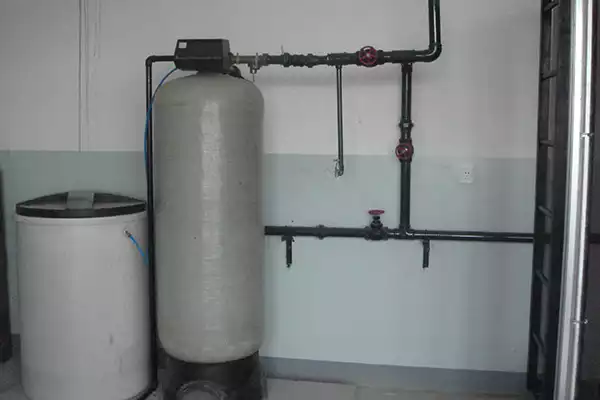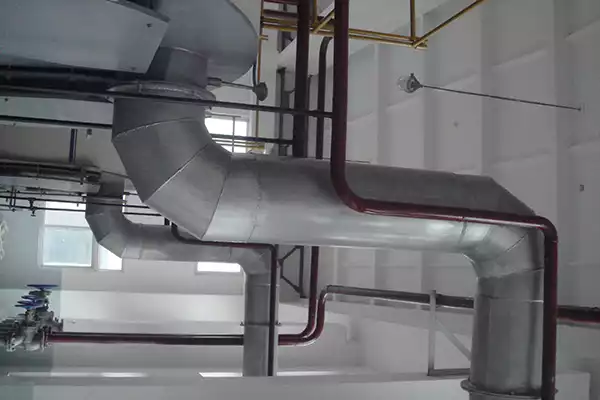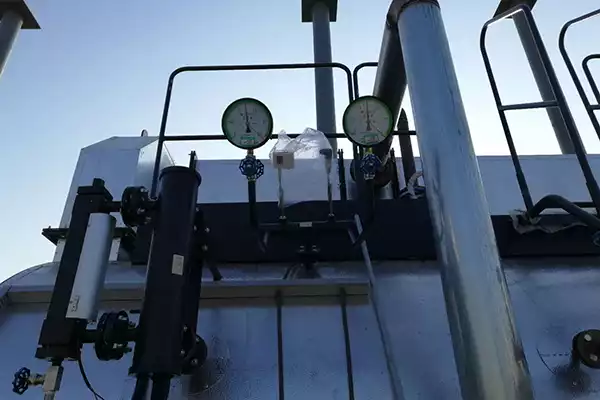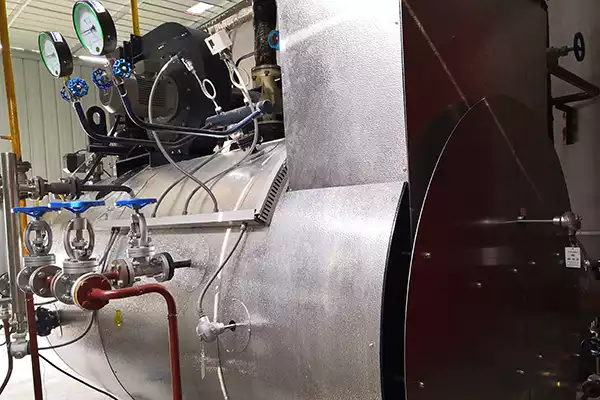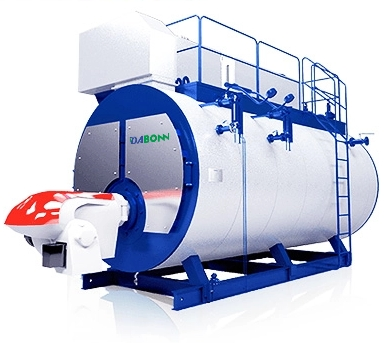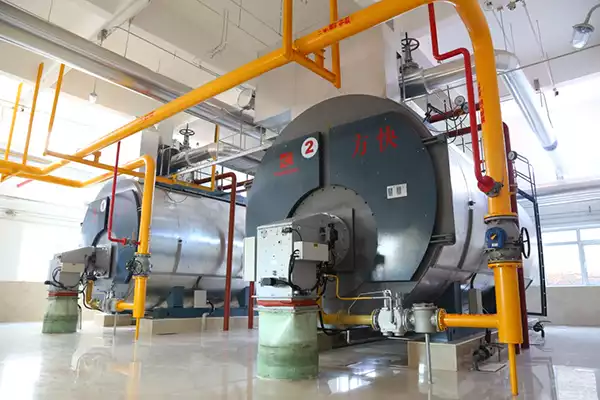
1. Water Hammer
Problem: Water hammer occurs when steam and condensate rapidly mix in the pipes, leading to loud banging noises and potential damage.
Causes:
- A rapid change in system pressure (for example, when opening a valve)
- A rapid change in system temperature (for example, when turning on an electric heater)
Solution:
- Install water hammer arrestors: These devices absorb the shock caused by sudden condensate movements.
- Use air vents: Properly placed air vents help remove air from the system, reducing the likelihood of water hammering.
- Maintain proper drainage: Ensure that condensate drains are clear and free of blockages.
2. Making Noise
Problem: The steam boiler makes noise when the water level is low or when heating and cooling. Noise can even occur if there is a trap problem, a valve problem, or damaged pipes.
Solution:
- Regularly inspect and maintain the system: This includes checking steam traps, valves, and pipes for damage or wear.
- Replace damaged components: If you identify worn-out or damaged parts, replace them promptly to restore system integrity and reduce noise.
3. Freeze Up
Problem: Freeze-up occurs when water condenses on the surface of a hot surface causing damage to the equipment and even personal injury. Also, in cold climates, steam boilers can freeze too. Causing operational disruptions and potential damage.
Solution:
- Insulate pipes and boiler: Proper insulation helps maintain higher temperatures and prevents freezing.
- Use antifreeze additives: In extremely cold conditions, adding antifreeze to the system can protect it from freezing.
- Maintain adequate heating: Ensure that the heating system operates continuously during winter to prevent freezing.
4. Air Binding
Problem: Air can build up in the steam piping system, It will not only impede steam flow but reduce system efficiency. Also, It will cause damage to the boiler and make noise and vibration.
Solution:
- Install air vents: Properly placed air vents help remove trapped air from the system.
- Ensure proper venting during startup: Open vents and bleed valves to release air when starting up the system.
5. Condensate Pipe Frozen
Problem: Condensate pipes can freeze in cold weather, leading to blockages and potential damage.
Causes: The most common reason for condensate pipe freezing is that the temperature of the water inside your system has dropped below 32 degrees Fahrenheit (0 degrees Celsius). This may be caused by either.
- Insufficient heat being applied to your heating system (for example, if you have an older boiler that doesn’t produce as much heat)
- A fault within one of its components (such as a faulty thermostat).
Solution:
- Insulate condensate pipes: Proper insulation prevents heat loss and freezing.
- Ensure proper drainage: Ensure that condensate drains are clear and well-maintained.
- Use trace heating: Trace heating cables can keep condensate pipes warm in extremely cold conditions.
6. Condensate Build-Up
Problem: Excessive condensate build-up in the system can reduce boiler efficiency and potentially lead to water hammering.
Causes:
- A leaky steam trap or pipe joint.
- Water hammer (the sudden stop of hot water flow).
Solution:
- Regularly inspect and maintain steam traps: Properly functioning steam traps remove condensate efficiently.
- Ensure proper drainage: Ensure that condensate drains are clear and free of blockages.
7. No Steam Production
Problem: When a boiler fails to produce steam, it can disrupt operations and may indicate various issues.
Solution:
- Check fuel supply: Ensure that the boiler has an adequate supply of fuel.
- Monitor water level: Low water levels can prevent steam production, so maintain the proper water level.
- Inspect the ignition system: Ensure that the ignition system is functioning correctly.
- Verify safety devices: Check that safety devices are operational and not tripped.
- Consult a professional: If issues persist, it’s advisable to consult a qualified technician for in-depth diagnostics and repairs.
8. Steam Locking
Problem: Steam locking occurs when air or condensation blocks the steam flow, leading to uneven heating. Steam locking can also occur if there is dirt in your condensate lines or traps that need cleaning out.
Solution:
- Install proper steam traps: Steam traps help remove condensate and air, preventing blockages.
- Ensure steam piping slope: Properly sloped piping facilitates condensate drainage and minimizes the risk of steam locking.
9. Steam Leakage
Problem: The rupture of the boiler tube or pipe causes steam leakage, which can lead to serious damage and reduce efficiency. It can also be dangerous due to high temperatures and pressure.
Solution:
- Regularly inspect and maintain the system: Check valves, fittings, and gaskets for damage or wear.
- Replace faulty components: If you identify any leaks, replace or repair valves, fittings, or gaskets promptly.
- Ensure tight connections: Properly tighten all connections to prevent leaks.
10. Uneven Steam Distribution
Problem: If the steam contacts only one side of a heated surface, it can cause uneven heating and result in poor performance and process disruptions.
Solution:
- Adjust valve positions: Ensure that steam control valves are adjusted correctly to achieve even steam distribution.
- Maintain steam traps: Properly functioning steam traps help maintain balanced steam flow.
11. Insufficient Steam Temperature
Problem: Insufficient steam temperature can affect processes and comfort in heating applications.
Solution:
- Check boiler operating pressure: Ensure that the boiler operates within the desired pressure range to achieve the required steam temperature.
- Maintain proper insulation: Adequate insulation on steam lines prevents heat loss and maintains steam temperature.
12. Dirt and Scaling
Problem: If you have a dirty boiler, it will not operate as efficiently or safely. It can also reduce boiler efficiency and damage your heat exchanger and other parts of your system.
Solution:
- Regularly clean and descale the boiler and piping: Implement a maintenance schedule to remove dirt and scale buildup.
- Water treatment: Implement a water treatment program to prevent scale formation in the first place.
13. Corrosion
Problem: Corrosion occurs when water condenses on exposed metal surfaces and rusts them over time. It can lead to equipment damage and safety hazards within the boiler system.
Solution:
- Use corrosion-resistant materials: Choose materials that are resistant to corrosion, especially in critical components.
- Maintain proper water chemistry: Implement a water treatment program to control water chemistry and prevent corrosion.
- Install protective coatings: Use protective coatings or linings in areas prone to corrosion.
14. Pressure Drop
Problem: Pressure drop is the difference between the pressure in your steam system and atmospheric pressure. When you’re at sea level, it’s equal to 14.7 PSI (pounds per square inch). If there’s less than 14 PSI in your system you measure it with a manometer (pressure gauge).
Solution:
- Inspect the entire system: Conduct a thorough inspection to identify and address any leaks or issues.
- Monitor pressure gauges: Regularly monitor pressure gauges to detect and address pressure fluctuations promptly.
15. Indicator Light Remains Off
Problem: If the indicator light remains off, check the fuses and circuit breakers. Make sure that they have not been tripped by an overload of current or some other event. Check all wiring connections to make sure they are secure, especially those that connect to the boiler itself and its controls.
Solution:
- Check electrical connections: Ensure that all electrical connections are secure and free of damage.
- Inspect fuses and safety switches: Verify that fuses and safety switches are intact and functioning correctly.
- Consult the boiler’s manual: Refer to the manufacturer’s manual for troubleshooting steps.
- Seek professional assistance: If problems persist, consult a qualified technician to diagnose and repair electrical or control issues.
How do I prevent a steam boiler troubleshooting?
Preventing steam boiler failure is crucial to ensure the safety, efficiency, and longevity of your system. Here are essential steps to prevent steam boiler failure.
Regular Inspection and Maintenance:
- Implement a comprehensive maintenance schedule. Regularly inspect all components, including the boiler, steam traps, valves, safety devices, and piping.
- Clean and descale the boiler and steam lines as needed to prevent blockages and efficiency loss.
Water Treatment: Implement a robust water treatment program to control water quality and minimize scale and corrosion. Proper water treatment prevents damage to the boiler and associated components.
Monitor Water Level:
- Maintain the proper water level in the boiler at all times. Low water levels can lead to overheating and boiler failure.
- Ensure that water level control systems, such as feedwater pumps and low-water cutoff devices, are in good working order.
Pressure Control:
- Install and maintain pressure-relief valves to prevent overpressure situations that could lead to boiler failure.
- Monitor and control the boiler’s operating pressure within safe limits.
Fuel Supply: Regularly inspect and maintain fuel supply systems to ensure a consistent and clean fuel source. Fuel quality can impact boiler performance and safety.
Safety Devices:
- Ensure that all safety devices, such as pressure relief valves, low-water cutoffs, and flame detectors, are regularly tested and functioning correctly.
- Periodically conduct safety audits to verify compliance with regulatory requirements.
Proper Ventilation: Maintain adequate ventilation in the boiler room to prevent the accumulation of harmful gases and ensure combustion air supply.
Operator Training:
- Train boiler operators thoroughly on safe and efficient boiler operation.
- Make sure operators are familiar with emergency procedures and know how to respond to potential issues.
Emergency Procedures:
- Develop and regularly review emergency procedures, including shutdown protocols and evacuation plans.
- Keep emergency contact information readily available.
Documentation and Records:
- Maintain detailed records of maintenance activities, inspections, and repairs.
- Keep historical data on boiler performance and incidents for analysis and improvement.
Spare Parts Inventory: Maintain an inventory of critical spare parts to address potential failures promptly.
Consult Professionals:
- When in doubt or faced with complex issues, consult with qualified boiler technicians and engineers.
- Regularly engage with boiler manufacturers and service providers for expert advice.
Conclusion.
If you’re experiencing one of the above problems with your steam boiler, it’s important to address it quickly. They can be very dangerous if they aren’t working properly and need to be serviced regularly. If you notice any issues with your boiler or heater, contact us today: 0086 186-2391-5479!
FAQs.
How to adjust the pressure of a steam boiler?
To adjust the pressure of a steam boiler, first, identify the pressure control device, often a pressure tool. It's crucial not to exceed safe operating limits, and adjustments may require the boiler to be shut down temporarily.
How to add water to a steam boiler?
Use a feedwater pump or manually open the feedwater valve to introduce water into the boiler until the desired level is reached, typically indicated by a sight glass or gauge. Be cautious not to overfill the boiler.
How to drain a steam boiler?
First, turn off the power and allow the boiler to cool. Then, Attach a hose to the boiler's drain valve, open the valve, and let the water and sediment drain into a suitable container. Finally, close the valve tightly once finished.
How to clean a steam boiler?
This is typically done through chemical cleaning or mechanical methods like descaling and flushing. Consult the boiler's manual and consider hiring a professional for comprehensive cleaning to avoid damage.
Get your best price
Quickly compare 3 FREE quotes
- Engineer quick quote
- The overall delivery speed is fast
- Financial choice
- Low installation costs and cost savings
25 years+ of boiler R&D
More than 20 innovative technologies
